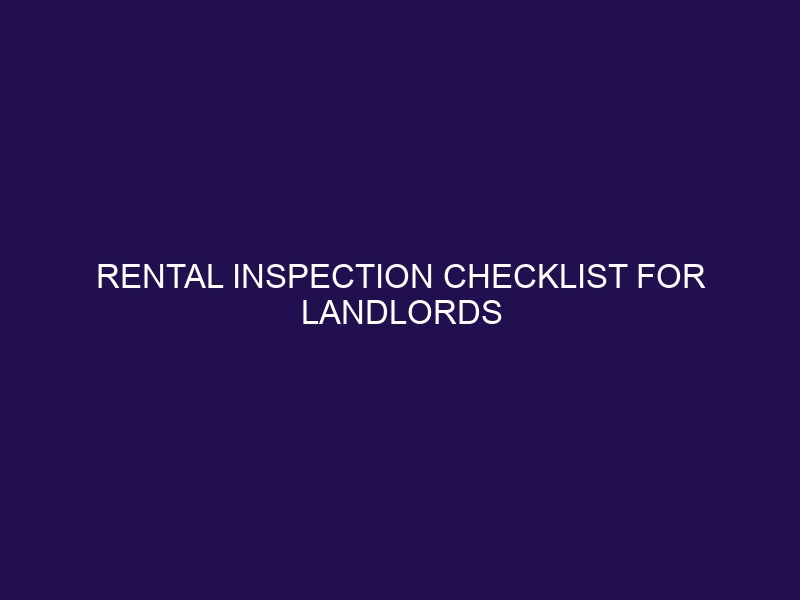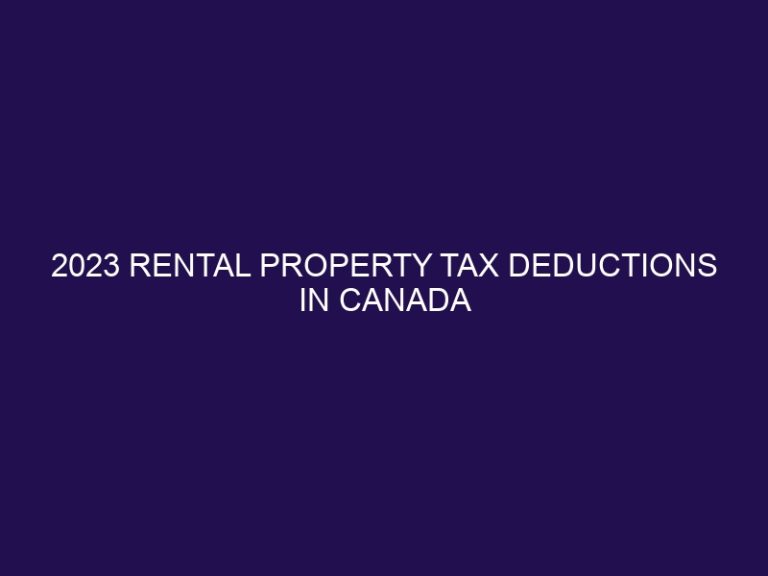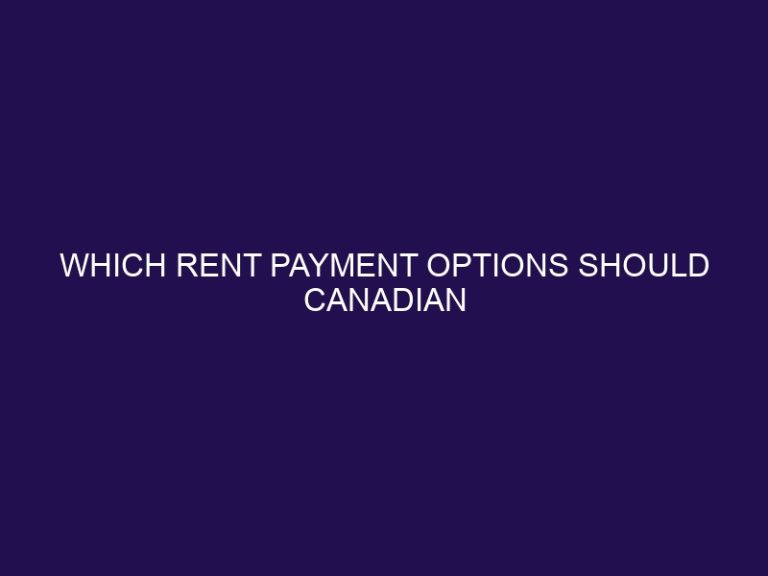Rental inspection checklist for landlords
A rental inspection checklist is an essential tool for landlords to ensure the proper maintenance and upkeep of their rental properties. It serves as a comprehensive guide to conduct thorough inspections, document any issues or damages, and effectively communicate with tenants. This rental inspection checklist provides a step-by-step framework for landlords to follow, ensuring that no aspect of the property goes unnoticed during the inspection process.
First and foremost, understanding the importance of a rental inspection checklist is crucial. It helps landlords identify any potential problems, assess the condition of the property, and address maintenance issues promptly. a checklist serves as evidence in case of disputes or claims, protecting the interests of both the landlord and the tenant.
To prepare for the rental inspection, landlords need to follow several key steps. Scheduling the inspection in advance allows tenants to make necessary arrangements and ensures a convenient time for all parties involved. It is essential to provide adequate notice to the tenants, clearly stating the purpose, date, and time of the inspection.
Gathering the necessary tools and supplies beforehand is essential to conduct a thorough inspection. This may include a flashlight, camera or smartphone for documentation, notepad or checklist, measuring tape, and any other equipment specific to the property’s features.
Once prepared, landlords can proceed with the exterior inspection of the property. This involves assessing the landscaping and yard, checking the condition of the roof and gutters, inspecting windows and doors for any damages or security issues, and examining the exterior walls and paint for signs of wear and tear.
Moving on to the interior inspection, landlords should carefully evaluate each area of the property. This includes the entryway and common areas, kitchen and appliances, living room and dining area, bedrooms, and bathrooms. Taking note of any damages, malfunctions, or cleanliness issues is crucial during this process.
Documenting the inspection findings is essential for record-keeping purposes. Landlords should take detailed photos or videos to provide visual evidence of the property’s condition. noting down any issues or damages in writing ensures clarity and serves as a reference for future inspections or repairs.
Effective communication with tenants is another crucial aspect of the rental inspection process. Providing feedback and following up with tenants regarding the inspection findings creates transparency and fosters a positive landlord-tenant relationship. Addressing any repair or maintenance requests promptly is also necessary to ensure tenant satisfaction and the overall well-being of the property.
Lastly, landlords must be aware of the legal considerations surrounding rental inspections. Familiarizing themselves with state and local laws is crucial to conduct inspections within the legal framework. Understanding tenant rights and responsibilities ensures fair and lawful inspections that protect the interests of all parties involved.
By following this rental inspection checklist and adhering to best practices, landlords can effectively manage their properties, maintain a healthy relationship with tenants, and ensure the longevity and profitability of their rental investments.
Rental Inspection Checklist: A Guide for Landlords
Rental Inspection Checklist: A Guide for Landlords
A rental inspection checklist is crucial for landlords to ensure the condition of their property and protect their investment. Here is a comprehensive guide to creating a rental inspection checklist:
- Exterior: Check the roof, gutters, siding, windows, and doors for any damage or maintenance issues.
- Interior: Inspect every room, including walls, ceilings, floors, doors, and windows for any signs of damage or wear and tear.
- Appliances and systems: Test all appliances, electrical systems, plumbing fixtures, heating, and cooling systems to ensure they are in proper working order.
- Safety measures: Verify the presence and functionality of smoke detectors, carbon monoxide detectors, and fire extinguishers.
- Documentation: Take detailed notes, photographs, and videos of any existing damage or issues to protect yourself and the tenant.
Why is a Rental Inspection Checklist Important?
A rental inspection checklist is important for several reasons. It ensures a thorough examination of rental properties, enabling landlords to document any existing damages or issues both before tenants move in and after they move out. This checklist serves as a reference point and evidence in case disputes arise regarding repairs or security deposits. By providing a clear record of the property’s condition, it helps prevent conflicts and protects landlords from liability. Additionally, it ensures that tenants are aware of their responsibilities for maintaining the property. Ultimately, a rental inspection checklist is a vital tool for landlords to safeguard their investment and maintain a positive landlord-tenant relationship. To enhance its effectiveness, landlords should consider incorporating a digital format and utilizing property inspection software for easy access, storage, and sharing of inspection reports.
Preparing for the Rental Inspection
Preparing for a rental inspection? Let’s dive in and get you ready! In this section, we’ll cover three key steps to ensure a smooth inspection process. First, we’ll discuss how to schedule the inspection, making sure you find a suitable time that works for both you and your tenants. Then, we’ll delve into the importance of notifying your tenants in advance, giving them ample time to prepare. We’ll talk about gathering the necessary tools and supplies you’ll need to conduct a thorough inspection. Let’s get started!
Schedule the Inspection
Scheduling the rental inspection is a crucial step for landlords to ensure a smooth and organized process. Here are the steps to schedule the inspection:
- Coordinate with the tenants to find a convenient time for both parties.
- Provide sufficient notice in accordance with local regulations, typically 24-48 hours in advance.
- Confirm the date and time of the inspection with the tenants to avoid any misunderstandings.
Notify the Tenants
NOTIFY THE TENANTS
To ensure that the tenants are prepared and aware of the upcoming rental inspection, it is important to notify them in advance. This courtesy allows them the opportunity to tidy up and take care of any issues prior to the inspection. As required by state and local laws, it is recommended to send a notice at least 24 to 48 hours in advance. In this notice, clearly communicate the date, time, and purpose of the inspection. Considering using multiple methods of notification, such as email, text message, and a notice posted in a common area. Additionally, offering a reminder the day before the inspection can help the tenants remember and make any necessary preparations.
Gather Necessary Tools and Supplies
- Gathering necessary tools and supplies is crucial for conducting a rental inspection efficiently and effectively. Here is a list of essential items:
- Checklist: Have a printed or digital copy of the rental inspection checklist to ensure thoroughness.
- Camera: Use a camera or smartphone to document the condition of the property visually.
- Tape measure: Measure room dimensions, furniture placement, or any other necessary measurements.
- Flashlight: Inspect dark areas or corners to identify any issues or damages.
- Notepad and pen: Take notes of any observations, damages, or repairs required.
- Protective gear: Wear gloves and a mask to protect yourself during the inspection.
- Cleaning supplies: Have cleaning products and tools to address minor issues on the spot.
- Key or access tools: Ensure you have the necessary keys or access tools to examine all areas, including locked spaces.
Exterior Inspection
Get ready to step outside and examine every inch of the property in the Exterior Inspection section. From the lush landscaping to the sturdy roof, we’ll cover it all. We’ll dive into the condition of the windows and doors, and give attention to the exterior walls and paint. So, grab your checklist and let’s make sure the exterior of your rental property is in top-notch shape before your next tenant moves in!
Landscaping and Yard
A well-maintained landscaping and yard can elevate the overall appearance of a rental property and entice potential tenants. Here are some essential elements to include in a rental inspection checklist for landscaping and yard:
| Meticulously mowing the lawn on a regular basis to keep it neat and well-trimmed. |
|---|
| Prudently trimming trees and bushes to uphold a tidy appearance. |
| Eradicating weeds and upkeeping flower beds and garden areas. |
| Ensuring that pathways and driveways are unobstructed and devoid of debris. |
| Thoroughly checking lawn irrigation systems to ensure optimal functionality. |
| Inspecting fences, gates, and outdoor lighting for any signs of damage or necessary repairs. |
| Maintaining cleanliness and freedom from trash or clutter in outdoor areas. |
Fact: A well-maintained yard not only enhances the curb appeal of a rental property but also fosters a welcoming environment for tenants to relish outdoor spaces.
Roof and Gutters
- Inspecting the roof and gutters is a crucial part of a rental inspection checklist for landlords. Here are some key points to consider in this area:
- Check for any visible signs of damage or wear on the roof and gutters, such as missing shingles, cracks, or leaks.
- Inspect the gutters to ensure they are clear of debris and functioning properly, directing water away from the property.
- Look for any signs of water pooling or damage around the roof and gutter areas.
- Document any issues or repairs needed, taking photos or videos as evidence.
- Consider scheduling regular maintenance, such as gutter cleaning or roof inspections, to prevent future problems.
By thoroughly examining and maintaining the roof and gutters, landlords can protect the property and provide a safe and comfortable living environment for their tenants.
Windows and Doors
Inspecting windows and doors, which are essential elements in the rental property, is a crucial part of the rental inspection process for landlords. It helps ensure the safety and functionality of these elements. Here are some key areas to focus on during the inspection of windows and doors in rental property:
- Check for any cracks, chips, or damage on windowpanes or door frames.
- Inspect the operation of windows and doors, ensuring they open, close, and lock properly.
- Look for any signs of moisture or leaks around windows or doors.
- Check the weather-stripping and seals to ensure they are intact and effectively insulating the property.
- Verify that all windows and doors have proper screens to prevent pests from entering the property.
Maintaining windows and doors is crucial for energy efficiency, security, and tenant satisfaction. Regular inspections and prompt repairs or replacements when needed can help landlords provide a safe and comfortable living environment for their tenants.
Exterior Walls and Paint
When conducting a rental inspection, it’s important to thoroughly assess the condition of the exterior walls and paint. This ensures that the property is well-maintained and any necessary repairs or touch-ups can be addressed.
- Inspect for Cracks: Look for any cracks or damage on the exterior walls that may need to be repaired to prevent further deterioration.
- Check for Peeling or Chipping Paint: Examine the paint on the exterior walls for any signs of peeling, chipping, or fading, as this can affect the overall appearance of the property.
- Assess the Color: Ensure that the paint color is consistent and matches the rest of the property. Any noticeable color discrepancies should be noted for potential touch-ups.
- Look for Water Damage: Check for any signs of water damage, such as stains or discoloration, which may indicate leaks or improper drainage.
- Inspect Trim and Siding: Pay attention to the condition of the trim and siding, checking for any cracks, rot, or damage that may require repairs.
Interior Inspection
Step into the world of rental property inspections as we dive deep into the interior inspection process. Discover the secrets that lie within the entryway and common areas, get a taste of the kitchen and appliances, explore the nooks and crannies of the living room and dining area, peek into the cozy bedrooms, and finally, witness the serenity of the bathrooms. Prepare to be amazed as we unravel the essence of each sub-section and provide you with expert insights for a smooth and successful inspection.
Entryway and Common Areas
When conducting a rental inspection, it’s crucial to thoroughly assess the entryway and common areas of the property. This part of the inspection helps ensure the overall cleanliness and functionality of shared spaces.
- Entryway: Check the condition of the entry door, including any locks or security features.
- Lighting: Verify that all light fixtures are working properly and provide sufficient illumination.
- Flooring: Inspect the flooring for any signs of damage, such as stains, scratches, or loose tiles.
- Walls and paint: Examine the walls for any marks, scuffs, or chipped paint that may require touch-ups.
- Common areas: Evaluate the cleanliness and organization of shared spaces, such as hallways or lobbies.
A well-maintained entryway and common areas contribute to a positive living experience for tenants and can help attract potential renters.
True history: In 2019, a rental inspection revealed a damaged entry door at an apartment complex. Prompt repairs were made, ensuring the safety and security of all residents. The inspection highlighted the need for improved lighting in the common areas, resulting in the installation of energy-efficient LED lights for better visibility and reduced electricity costs.
Kitchen and Appliances
When conducting a rental inspection, thoroughly assessing the kitchen and appliances is crucial for both landlords and tenants. Here are some key areas to focus on:
- Cabinets: Inspect for any damage, such as broken hinges or loose handles.
- Countertops: Check for any chips, cracks, or stains that may require repairs or replacement.
- Appliances: Test each appliance to ensure they are in proper working condition. Look for signs of wear and tear, such as rust or malfunctioning components.
- Plumbing fixtures: Inspect the sink, faucet, and dishwasher for leaks, clogs, or any other plumbing issues.
- Electrical components: Check that all outlets, switches, and lights are functioning correctly and there are no safety hazards.
- Ventilation: Assess the range hood and exhaust fan to ensure they are properly ventilating the kitchen.
Living Room and Dining Area
When conducting a rental inspection, it is essential to thoroughly assess the living room and dining area to ensure they are in good condition.
- Cleanliness: Check for any dust, dirt, or stains on the walls, floors, and furniture in the living room and dining area.
- Furniture: Inspect the condition of the sofas, chairs, tables, and other furniture in the living room and dining area. Look for any tears, stains, or damage.
- Lighting: Ensure that all light fixtures in the living room and dining area are working properly and bulbs are not burnt out.
- Windows and Curtains: Examine the windows in the living room and dining area for cleanliness and any damages. Check if the curtains or blinds in these areas are in good condition.
- Electrical Outlets: Test all electrical outlets in the living room and dining area to ensure they are functioning correctly.
- Smoke Detectors: Verify that smoke detectors are present and in working condition in the living room and dining area.
To maintain a pleasant living space for tenants, consider providing suggestions such as adding cozy decorations, organizing the space efficiently, and encouraging regular cleaning and maintenance in the living room and dining area.
Bedrooms
When conducting a rental inspection, it is crucial for landlords to thoroughly assess the bedrooms. Here are some crucial points to consider during the inspection:
- – Examine the walls, floors, or ceilings for any indications of damage or wear.
- – Ensure that all windows in the bedrooms are in good condition, with functioning locks and no cracks.
- – Inspect the closet doors and shelves to ensure they function properly and are stable.
- – Test all electrical outlets, switches, and lighting fixtures in the bedrooms for proper operation.
- – Look for any signs of pests or rodents in the bedrooms, such as droppings or chewed furniture.
Fun fact: Did you know that according to a survey, the average person spends about one-third of their life in their bedroom?
Bathrooms
When conducting a rental inspection, it’s essential to thoroughly assess the conditions of the bathrooms in the property. Bathrooms are a critical area to focus on when evaluating a rental property. Here are some key areas to pay attention to:
- 1. Cleanliness: Check for any signs of dirt, mold, or mildew in the shower, tub, sink, and toilet areas.
- 2. Plumbing: Test the faucets, showerheads, and toilets for any leaks, drips, or water pressure issues.
- 3. Ventilation: Ensure that the bathrooms have proper ventilation systems, such as fans or windows, to prevent moisture buildup and potential damage.
- 4. Fixtures and Accessories: Inspect the condition of the towel racks, mirrors, toilet paper holders, and any other fixtures or accessories in the bathrooms.
- 5. Safety: Check if there are any loose tiles, slippery surfaces, or exposed electrical wires that could pose safety hazards.
Documentation and Record-Keeping
When it comes to documentation and record-keeping in the world of rental inspections, there are two key aspects to focus on: capturing visuals through photos or videos, and noting down any issues or damages. These sub-sections play a crucial role in ensuring a thorough and accurate record of the property’s condition. So, grab your camera and pen, because we’re about to dive into the art of documenting every nook and cranny in detail.
Take Photos or Videos
Taking photos or videos during a rental inspection is crucial for documentation and record-keeping purposes. It is important to take photos or videos as evidence of the property’s condition before and after the tenancy. This process ensures the protection of both landlords and tenants. Here are some reasons why taking photos or videos is important:
- Accuracy: Taking visual evidence captures the true state of the property, helping to avoid disputes about damages or maintenance issues.
- Documentation: Taking photos or videos serves as a record of the property’s condition, making it easier to track any changes or damages over time.
- Communication: Sharing the visual evidence with the tenants allows for clear and transparent communication about any issues that need to be addressed.
- Legal Protection: In the event of disagreements or legal disputes, the photos or videos can serve as solid evidence in court.
Remember to always obtain consent from tenants before taking any photos or videos. Also, make sure to store these records securely for future reference.
Note Down any Issues or Damages
- Take thorough inspection of each area and room and note down any issues or damages.
- Be sure to document any visible damages such as broken windows, stains on walls, or malfunctioning appliances.
- Check for any signs of water damage, mold, or pest infestation and make a record of it.
- Examine the flooring for scratches, tears, or any other indications of wear and tear and note them down.
- Make a record of any plumbing or electrical issues like leaks, faulty outlets, or flickering lights.
- Take note of any missing or damaged fixtures, such as broken doorknobs or loose cabinet handles.
- Record any safety hazards, including exposed wiring or uneven flooring.
- Make sure to document any repairs or maintenance needed to restore the property to its original condition.
Communication with Tenants
Maintaining effective communication with tenants is crucial for landlords to ensure a smooth rental experience. In this section, we will explore two key aspects of tenant communication: providing feedback and follow-up, and addressing repair or maintenance requests. Discover how timely and clear communication fosters a positive landlord-tenant relationship, resulting in tenant satisfaction and ultimately, a well-maintained rental property.
Provide Feedback and Follow-Up
After conducting a rental inspection, it is crucial for effective communication and maintaining a healthy landlord-tenant relationship to provide feedback and follow-up.
Address any Repair or Maintenance Requests
When conducting a rental inspection, it is crucial for landlords to promptly address any repair or maintenance requests from tenants. This ensures a safe and habitable living environment for tenants and helps maintain the property’s overall condition. Landlords should have a system in place to document and prioritize these requests, communicating with tenants about the timeframe for addressing the issues. Promptly addressing repair and maintenance requests not only demonstrates good landlord-tenant communication but also prevents further damage to the property and potential legal issues. Cultivating a proactive approach to repairs and maintenance promotes tenant satisfaction and helps preserve the property’s value by addressing all repair or maintenance requests promptly.
Legal Considerations
To navigate the world of rental inspections, it’s crucial to be aware of the legal considerations. In this section, we’ll explore two key aspects: knowing your state and local laws, and understanding tenant rights and responsibilities. By delving into these topics, you’ll gain the necessary insights to ensure a smooth and compliant rental inspection process. Stay tuned to learn how you can navigate the legal landscape and establish a solid foundation for successful landlord-tenant relationships.
Know Your State and Local Laws
It is crucial as a landlord to know your state and local laws when conducting rental inspections. Each jurisdiction may have specific regulations that govern the inspection process and protect the rights of tenants. To ensure compliance and avoid legal issues, it is important for landlords to become familiar with these laws.
Here are some suggested tips for understanding state and local laws:
- Research: It is essential to thoroughly investigate the laws and regulations regarding rental inspections in your specific area.
- Seek Legal Advice: Consulting with a lawyer who specializes in landlord-tenant laws will help you gain a clear understanding of your rights and responsibilities.
- Stay Updated: Laws may change over time, so make sure to regularly review any updates or amendments to the regulations.
- Document Everything: Keeping detailed records of inspections, communication with tenants, and any repairs or maintenance performed is crucial.
By knowing your state and local laws, you can confidently conduct rental inspections while respecting the rights of your tenants and fulfilling your obligations as a landlord.
Understand Tenant Rights and Responsibilities
As a landlord, it is crucial to understand tenant rights and responsibilities during rental inspections. By familiarizing yourself with state and local laws, you can ensure that you are conducting inspections within legal boundaries. It is important to communicate clearly with tenants, providing them with feedback and addressing any repair or maintenance requests promptly. Documenting any issues or damages that arise during the inspection is essential for record-keeping purposes. By comprehending and respecting tenant rights, you can maintain a positive landlord-tenant relationship and ensure a smooth rental inspection process.
Frequently Asked Questions
What is a move-in inspection for rental property?
A move-in inspection is a thorough assessment of the rental property’s condition before a tenant moves in. It aims to document the property’s state and identify any pre-existing damage or issues. This inspection is essential to prevent future disputes over damages and ensure transparency between landlords and tenants.
How often should a landlord conduct rental property inspections?
Landlords should conduct rental property inspections at different intervals. Move-in inspections should be done before a tenant moves in. Quarterly inspections are recommended, which means four inspections per year, to assess the property’s current state and ensure tenant compliance. Finally, move-out inspections should be carried out after a tenant vacates the property.
How can landlords prevent legal action through rental inspections?
By regularly conducting rental inspections, landlords can proactively address maintenance issues and prevent them from escalating into more significant problems. This proactive approach helps avoid potential legal action from tenants due to neglected repairs or unresolved property issues. Inspections also provide a documented record of the property’s condition, protecting both landlords and tenants from future disputes.
What should landlords include in a rental inspection checklist?
A comprehensive rental inspection checklist should cover all key areas of the property, including but not limited to, walls, floors, electrical systems, plumbing, appliances, and doors/windows. It should also include a section for documenting pre-existing damage, if any, and note any concerns raised by the tenant. Including a signature line for both landlord and tenant ensures an accurate representation of the property’s condition.
How can landlords budget for maintenance based on rental inspections?
Rental inspections play a vital role in helping landlords plan for property upgrades and budget for maintenance. Through regular inspections, landlords can identify areas that need repairs, servicing, or upgrades. By addressing these issues promptly, landlords can estimate the associated costs and allocate a budget for maintenance, ensuring the property remains in good condition, and surprise expenses are minimized.
What should landlords do if the rental inspection reveals damage caused by the tenant?
If the rental inspection reveals damage caused by the tenant beyond normal wear and tear, the landlord should clearly document the damage and discuss it with the tenant. Depending on the severity, the tenant may be responsible for repairing the damages or covering the cost of repairs. Clear communication and understanding of the lease agreement terms are crucial in resolving such matters in the best interests of both parties involved.







